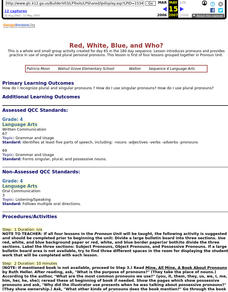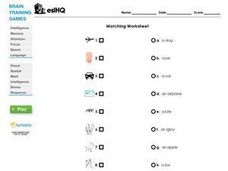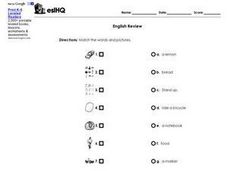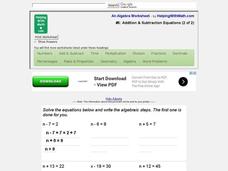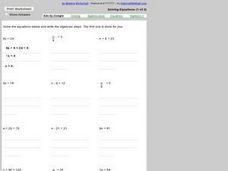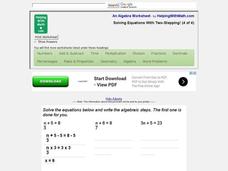Curated OER
Patterns Here, There, and Everywhere!
Upper graders access the Microsoft Word program and create patterns by utilizing certain keys on the keyboard. They create picket fences, smiley faces, and hearts. It seems that this lesson has as much to do with keyboarding skills as it...
Curated OER
Exploring Centers of Triangles
Students explore properties of triangles using angle bisectors, incenters, circles, midpoints, and altitudes. They use Geometer's Sketchpad in order to create triangles and their properties.
Curated OER
Piece of the Sky: Introduction for Making S'COOL Observations
Students observe and discuss cloud cover. They identify percent of cloud cover, calculate cloud cover by fraction and convert to a percent, and compare their models with the current real sky cloud cover.
Curated OER
How Did We Arrive at the Printed Book?
Seventh graders, in cooperative learning groups, research the development of book printing. After examining a story written on a scroll, an accordion book, and a printed copy, they evaluate them according to a certain criteria and...
Curated OER
Red, White, Blue, and Who?
Fourth graders are introduced to pronouns and provided practice in use of singular and plural personal pronouns.
Illustrative Mathematics
Combined Fuel Efficiency
Practice simplifying complex fractions and long division of polynomials with this brief exercise. These four questions make a challenging warm-up activity or a short, but comprehensive, follow-up after a detailed lesson on algebraic...
Curated OER
What Are the Odds?
Middle schoolers identify and interpret various ways of expressing probability as a decimal, fraction, percent, or ratio. They solve problems based on probability as they apply to real world applications.
Curated OER
I Must/ I Must Not
In this ESL word and picture comprehension worksheet, learners examine seven pictures and complete a multiple choice question for each. They answer the question that contains the words "must not" or "must."
Curated OER
ESL: Beginning Vocabulary Matching
Beginning English Learners match 10 line-drawn pictures of basic nouns with their names, such as kite, airplane, goat, and igloo. Indefinite articles are included, so this exercise also provides reinforcement for the a/an rule.
Curated OER
Various Questions
A great exercise for English language learners or youngsters learning how to question, this resource provides practice using pictures to recognize words. After the class has completed the fill-in-the-blank portion, have them walk around...
Curated OER
ESL: Basic Vocabulary Matching
Newcomers to English can practice vocabulary about food, daily actions, and school supplies with this 10-question matching exercise. Simple line drawings represent basic terms for beginners.
Curated OER
ESL: Classmates Survey
Get your beginning English Learners moving with this class survey. They ask each other the 8 questions provided to find out "How many of your classmates..." Good practice for asking questions that start with"Do you..." including "make...
Curated OER
Match: Word and Picture Comprehension
An excellent ESL word and picture matching activity awaits your students. They analyze seven pictures of body parts, and match these to the words that describe them.
Curated OER
ESL: Practice Using Present Progressive Tense
Small, cartoonish pictures of people expressing emotions and actions (blowing his nose, holding her head and frowning, dancing, smiling) provide the basis for writers to describe the feelings and experiences taking place. Help your ESL...
Curated OER
Yo! Gert-making yogurt
Young scientists or chefs culture yeast to produce yogurt. The materials and a general description of how make yogurt are provided, but there is very little detail otherwise. You could use this as an activity when your biology class is...
Curated OER
Make Bark and Leaf Rubbings
Students explore natural resources by creating art from plant materials. In this leaf rubbings lesson, students identify the plants that shed bark and leaves and discuss how it helps them survive in specific environments. Students...
Curated OER
Tangram Fractions
Students explore tangram puzzles. In this tangram fraction lesson, students read Grandfather Tang and then practice solving tangram puzzles. Students identify fractions of the pieces of the tangram puzzles and then create a design using...
Curated OER
Doing Lewis Dot Diagrams
Young scholars observe the periodic table and draw the Lewis Dot Diagram. For this investigative lesson students construct information on several elements including the Lewis Dot Formation and take a quiz on the information they...
Curated OER
Fraction Clue Box
Students distinguish between proper and improper fractions. They create a "Character Clue Box" that represents a fraction. Fractions are picked from a hat and then groups go outside and search for items that represent their fraction....
Helping with Math
#6: Addition and Subtraction Equations (2 of 2)
This printable contains 12 basic equations to be solved. The first one is worked out as an example, and the answers for all can be found by clicking on a "Show Answers" box found on the website. The publisher has identified this as...
Helping with Math
#5: Addition & Subtraction Equations (1 of 2)
Single-step addition or subtraction operations are applied in order to solve these 12 simple equations. An answer key is available, not so much for you, but perhaps to be used by learners as a self-correction tool. Note that the...
Helping with Math
#9: Solving Equations (1 of 2)
Twelve very simple equations are presented for learners to solve. What is the value of x? What is the value of n? Individuals apply operations to find the answers. You will find the final answers by clicking on the appropriate box at the...
Helping with Math
Solving Equations with Two-Stepping! (4 of 4)
Here are 12 two-step algebraic equations to be solved. The first problem is completed as an example to your class, but the remaining can be worked right on the page. An answer key is available by clicking on a small box at the top of the...
Helping with Math
Solving Equations with Two-Stepping! (2 of 4)
Multi-step problems are part of the progression when learning to solve equations. These 12 problems require only two steps to arrive at an answer. Either print the page out to assign as homework, or have learners write down the problems...




